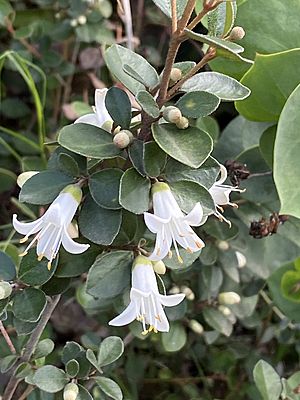White correa facts for kids
Quick facts for kids White correa |
|
|---|---|
 |
|
| In the Royal Tasmanian Botanical Gardens | |
| Scientific classification | |
| Genus: |
Correa
|
| Species: |
alba
|
| Synonyms | |
|
|
The White Correa (Correa alba) is a special type of shrub. It grows only in south-eastern Australia. This plant has leaves that look like eggs or are almost round. Its white flowers stand upright and grow alone or in small groups. After flowering, it produces green fruit.
Contents
What the White Correa Looks Like
The White Correa is a shrub that can grow low to the ground or spread out. It usually reaches about 1.5 meters (5 feet) tall. Its young stems are a rusty color and feel soft and woolly.
Its leaves are tough and feel like leather. They are shaped like an oval or are almost round. The leaves are about 8 to 35 millimeters (0.3 to 1.4 inches) long. They are also 6 to 25 millimeters (0.2 to 1 inch) wide. A short stalk, called a petiole, connects the leaf to the stem. The underside of the leaves is covered with thick, soft hairs.
The flowers grow alone or in groups of up to five. They appear at the ends of short side branches. Each flower sits on a small stalk called a pedicel. The base of the flower has a cup-shaped part called a calyx, which is 2 to 4 millimeters long. It has four small parts, or lobes.
The petals are usually white, but sometimes they can be light pink. They are about 11 to 13 millimeters (0.4 to 0.5 inches) long. The back of the petals is covered in soft hairs. The petals spread out, not touching each other much. Inside the flower are eight stamens, which are shorter than the petals.
White Correa mainly flowers from April to June. Its fruit is green and about 5 to 7 millimeters (0.2 to 0.3 inches) long.
How White Correa Got Its Name
The White Correa was first officially described in 1798. A person named Henry Cranke Andrews wrote about it. He included it in his book, The Botanist's Repository for New, and Rare Plants.
Today, plant experts recognize two main types, or varieties, of White Correa:
- Correa alba var. alba: This type has soft, woolly hairs pressed flat against the bottom of its leaves. Its flower stalks (pedicels) are 2.5 to 5 millimeters long.
- Correa alba var. pannosa: This type has very thick, woolly, or felt-like hairs on the underside of its leaves. Its flower stalks are shorter, about 0.5 to 1.5 millimeters long.
Where White Correa Grows
White Correa is found in several parts of Australia. These include South Australia, New South Wales, Victoria, and Tasmania.
In New South Wales, it grows in sandy and rocky areas near the coast. You can find it south of Port Stephens. In Victoria, it is common in coastal areas with heath plants and woodlands. It also grows in the far southeast of South Australia. In Tasmania, it is often seen on rocky and sandy areas along the north and east coasts.
The alba variety grows along the coasts of New South Wales. It also extends as far west as Cape Otway in Victoria. This is also the type found in Tasmania. The pannosa variety is found along the southwest coast of Victoria. It also grows as far east as the Encounter Bay area of South Australia.
White Correa and Animals
Wombats are known to eat the leaves and roots of the White Correa plant.
How People Use White Correa
Growing White Correa in Gardens
White Correa is a strong plant that is easy to grow in gardens. It does well in soil that drains water easily. It can also handle being near the coast, even with salty air. For the best flowers, it should be planted where it gets lots of sun. However, it can also grow in partial shade. People sometimes use it to make a natural fence or grow it in pots.
White Correa as a Drink
An old book from 1889, 'The Useful Native Plants of Australia', mentions this plant. It says that in Tasmania, people called it "Cape Barren Tea." The book also notes that seal hunters on islands in Bass Strait used the leaves as a substitute for tea.
See also
 In Spanish: Correa alba para niños
In Spanish: Correa alba para niños


